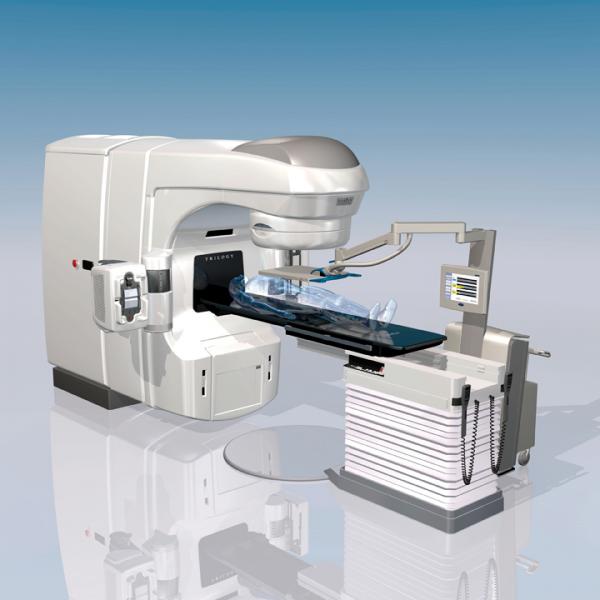In the past 20 years there have been considerable improvements in the treatment of prostate cancer. As it is across all radiation oncology, techniques have evolved from conventional external beam radiation therapy (EBRT), to more targeted therapies that are delivered in fewer visits. One of the latest notable trends in radiotherapy is the emergence of real-time image guidance for intensity-modulated radiation therapy (IMRT). For prostate cancer, radiotherapy is often deployed in conjunction with surgery (prostatectomy) or as curative therapy, depending on the stage of disease. As these new techniques emerge, it becomes more important for clinicians to identify which ones work most effectively and for which patients.
Types of Radiotherapy for Prostate Cancer
Radiation therapy can be divided into two main types: external and internal. Both forms have shown to be effective in treating prostate cancer, though more research and long-term information is available on the former.1 For prostate cancer, EBRT remains the standard, with IMRT becoming the most commonly used. Other external treatment options for patients include the older 3-D conformal radiation therapy (3D-CRT); and proton therapy, which uses targeted beams of proton particles rather than X-rays.
Internal radiation therapy, or brachytherapy, typically involves the use of small radioactive sources that are inserted into the prostate gland for direct delivery. There are two types of prostate brachytherapy: permanent low-dose rate (LDR) and temporary high-dose rate (HDR). LDR brachytherapy involves the insertion of radioactive seeds through the skin and into the prostate using thin needles. The seeds are tiny enough to avoid discomfort, and are typically left in place after radiation delivery is complete. In HDR brachytherapy, needles are used to insert catheters into the prostate. The catheters then deliver the radioactive materials into the gland for about five to 15 minutes.[1] Depending on the stage of disease and/or the size of the prostate gland, brachytherapy can be deployed to minimize damage to healthy tissues surrounding the prostate.
Evolution of Techniques
Steve Eulau, M.D., medical director and radiation oncologist, Seattle Prostate Institute, has been treating prostate cancer for almost 20 years. He noted the remarkable evolution of treatments available for patients, calling the pace of change “breathtaking.” Where before the amount of radiation used to treat patients was so overwhelming that men were discontinuing treatment, now beams are “being delivered to conform in a rational way to the anatomy of the patient,” he stated.
3D-CRT is considered an “older” technique that uses 3-D images of the tumor to shape more precise beams of radiation for treatment. The beams are projected using a linear accelerator (linac) from different angles around the patient, who remains situated in the same position on the table throughout each course of treatment. Another form of conformal therapy involves the use of proton beams rather than X-ray beams, though proton therapy is not yet widely available and only a handful of sites in the United States offer it as treatment.
Advanced variations of 3-D therapy include the now-routinely used IMRT, image-guided radiation therapy (IGRT) and volumetric modulated arc therapy (VMAT). IMRT allows radiation oncologists to not only shape radiation beams, but to also vary the intensity of those beams within a given field, said Eulau. Another external technique projects radiation from a geometric arc around the patient, rather than from a set of predetermined orientations and angles. Similar to IMRT, the RapidArc system, a proprietary technology from Varian Medical Systems, can adjust the shape and intensity of the beams when projecting at the patient, explained Agam Sharda, senior manager of treatment solutions marketing for Varian’s oncology systems business.
Ultimately, radiotherapy techniques have been evolving to become more accurate, precise and efficient. “What that helps to do is deliver maximum dose to the target, while limiting dose to sections that are not the target,” Sharda said. “As a result we are, in some cases, witnessing better side effects than with earlier techniques.”
The Advent of Real-Time Image Guidance
For Eulau, the development of real-time image guidance and tracking for therapy treatments has been transformational for radiation oncologists. Where before a computed tomography (CT) scan was used for planning and tracking during treatments, radiofrequency (RF) guidance now allows clinicians to know where the prostate is and its exact size during the actual procedure. In clinical use for the past four or five years, RF guidance contrasts significantly with CT, which only showed the prostate during the moment the image was taken. “Before, we ran the risk of deluding ourselves that we knew exactly where these fragile tissues were within the body,” said Eulau. As a result, past radiation delivery may have affected more normal tissue than desired.
A user of Varian’s Calypso real-time tracking system, Eulau now uses three RF beacons that are placed into the prostate. The beacons are activated from the console by clinicians, and the console detects wavelengths sent by the beacons to determine their locations. “It allows us to know exactly where we are with millimeter precision within the body, 10 times a second,” Eulau said.
Varian and other vendors are also using a variety of imaging modalities besides CT to develop guidance technologies. Varian’s Vitesse real-time planning solution uses ultrasound to guide and aid HDR brachytherapy treatments, and the first patient to be treated with the latest version of Vitesse was a prostate cancer patient in North Carolina. Earlier in 2013, Elekta and Philips Healthcare joined a research group that is developing a combination of magnetic resonance imaging (MRI) and radiation therapy for more precise cancer treatments.
CRT vs. IMRT
A comparative effectiveness study, published online in May by JAMA Internal Medicine, evaluated the long-term outcomes of patients who received radiation treatments following surgery, comparing CRT against the newer and more expensive IMRT.[2] The study, led by researchers from the University of North Carolina, compared outcomes using Medicare data of IMRT and CRT patients treated between 2002 and 2007. The researchers found no significant difference between IMRT and CRT patients in rates of long-term gastrointestinal morbidity, urinary incontinent morbidity, urinary incontinence or erectile dysfunction.
Lead author Ronald Chen, M.D., MPH, assistant professor of radiation oncology, University of North Carolina at Chapel Hill School of Medicine (UNC), cites the study as showing the possible long-term benefits of radiation treatment for patients who have had a prostatectomy. “For patients who have had a prostatectomy already, and subsequently need radiation treatment, this study shows that IMRT and CRT seemed to have similar outcomes,” he said in the release.
The study came at a time when leading urological and radiation oncology organizations announced a new guideline regarding radiation therapy after
prostatectomy.[3] Released jointly by the American Society for Radiation Oncology (ASTRO) and the American Urological Association (AUA) in May, the guideline provides recommendations about the benefits and risks of additional treatment after prostate removal. The “Adjuvant and Salvage Radiotherapy After Prostatectomy: ASTRO/AUA Guideline” was published in the August 2013 issues of the official journals of both ASTRO and AUA.
References:
1 www.cancer.org/cancer/prostatecancer/detailedguide/prostate- cancer-treating-radiation-therapy, accessed July 1, 2013
2 http://archinte.jamanetwork.com/article.aspx?articleid=1689975, accessed July 1, 2013
3 www.newswise.com/articles/view/602678/?sc=sphr&xy=10009115, accessed July 1, 2013



 December 04, 2025
December 04, 2025 









